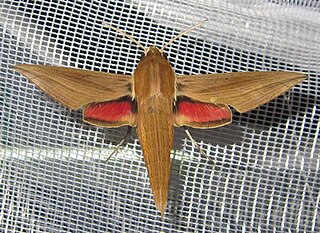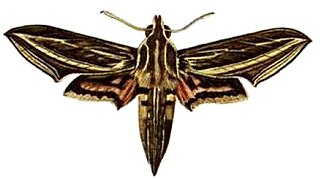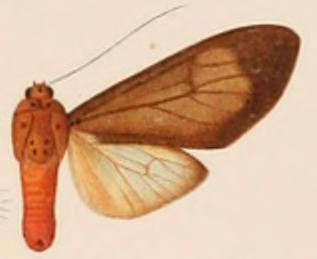
Moths are a paraphyletic group of insects that includes all members of the order Lepidoptera that are not butterflies, with moths making up the vast majority of the order. There are thought to be approximately 160,000 species of moth, many of which have yet to be described. Most species of moth are nocturnal, but there are also crepuscular and diurnal species.

Biston is a genus of large, long-winged moths belonging to the family Geometridae. It is most notable for containing the well-known peppered moth. The genus was first described by William Elford Leach in 1815.

The Ethiopian wolf, also called the Simien jackal and Simien fox, is a canine native to the Ethiopian Highlands. In southeastern Ethiopia it is also known as the horse jackal. It is similar to the coyote in size and build, and is distinguished by its long and narrow skull, and its red and white fur. Unlike most large canids, which are widespread, generalist feeders, the Ethiopian wolf is a highly specialised feeder of Afroalpine rodents with very specific habitat requirements. It is one of the world's rarest canids, and Africa's most endangered carnivore.

Cichorium is a genus of plants in the tribe Cichorieae within the family Asteraceae. The genus includes two cultivated species commonly known as chicory or endive, plus several wild species.
The Zulu serotine, also called the Zulu pipistrelle, aloe bat, or aloe serotine, is a species of vesper bat found in Angola, Botswana, Democratic Republic of the Congo, Ethiopia, Kenya, Malawi, Namibia, South Africa, South Sudan, Uganda, Zambia, and Zimbabwe. Its natural habitats are savanna and hot deserts.

The Thyatirinae, or false owlet moths, are a subfamily of the moth family Drepanidae with about 200 species described. Until recently, most classifications treated this group as a separate family called Thyatiridae.

Cephonodes hylas, the coffee bee hawkmoth, pellucid hawk moth or coffee clearwing, is a moth of the family Sphingidae. The species was first described by Carl Linnaeus in 1771. A widely distributed moth, it is found in the Near East, Middle East, Africa, India, Sri Lanka, Japan, Southeast Asia and Australia.

Donacaula is a genus of moths of the family Crambidae. The genus was erected by Edward Meyrick in 1890.

Hippotion eson is a moth of the family Sphingidae. It is very common in most habitats throughout the Ethiopian Region, including Madagascar and the Seychelles. It is a migratory species.

Hippotion osiris is a moth of the family Sphingidae. It is common throughout most of the Ethiopian Region, including Madagascar and the Seychelles. Occasional vagrants have been recorded from Spain. It is uncommon on the East African coast. This species is an occasional migrant.

Achaea praestans, the orange-bordered achaea, is a moth of the family Erebidae. The species was first described by Achille Guenée in 1852. It is found in South Africa, Ethiopia, Eswatini, Kenya, Madagascar, Malawi, Mozambique, Tanzania and Zimbabwe.
Coniostola is a genus of moths belonging to the subfamily Olethreutinae of the family Tortricidae.
Pterophorus rhyparias is a moth of the family Pterophoridae.

Oraesia emarginata is a species of moth of the family Erebidae first described by Johan Christian Fabricius in 1794. It is found in Australia, New Caledonia, Indonesia, New Guinea, Pakistan, the Philippines, India, Sri Lanka, Sulawesi, Taiwan, China, Japan, Korea and Nepal as well as Eritrea, Ethiopia, Kenya, Namibia, Nigeria, South Africa, Tanzania, the Gambia, Uganda, Oman and Yemen.

Amerila puella is a species of moth of the subfamily Arctiinae. It is found in Senegal, Sierra Leone, Ivory Coast, Ghana, Nigeria, Zaire, Uganda, Ethiopia, Kenya, Tanzania and Malawi.
William Warren was an English entomologist who specialised in Lepidoptera.
Simplicia extinctalis is a litter moth of the family Erebidae. It is found in most countries of subtropical Africa, from Sierra Leone to Somalia and from Ethiopia to South Africa, including some islands of the Atlantic Ocean and Indian Ocean, as well as in Yemen.
Creatonotos leucanioides is a moth of the family Erebidae. It was described by William Jacob Holland in 1893. It is found in Angola, Burkina Faso, Burundi, Cameroon, the Central African Republic, the Republic of the Congo, the Democratic Republic of the Congo, Ethiopia, Gabon, Ghana, Ivory Coast, Kenya, Liberia, Nigeria, Saudi Arabia, Sierra Leone, Sudan, Tanzania, the Gambia, Uganda, Yemen, and Zambia.
Podomachla apicalis is a moth of the family Erebidae. It is found in Angola, Cameroon, the Republic of Congo, the Democratic Republic of Congo, Equatorial Guinea, Eritrea, Ethiopia, Gabon, Ghana, Kenya, Liberia, Malawi, Mozambique, Nigeria, Sierra Leone, South Africa, São Tomé & Principe, Tanzania, Togo and Uganda.
Zebronia phenice is a moth in the family Crambidae. It was described by Stoll in 1782. It is found in Cameroon, Mayotte, the Democratic Republic of Congo, Equatorial Guinea, Ethiopia, Gabon, Ghana, Ivory Coast, Kenya, La Réunion, Madagascar, Mauritius, Mozambique, Nigeria, Senegal, Sierra Leone, South Africa, Tanzania, Gambia, Uganda, Zambia and Zimbabwe.









